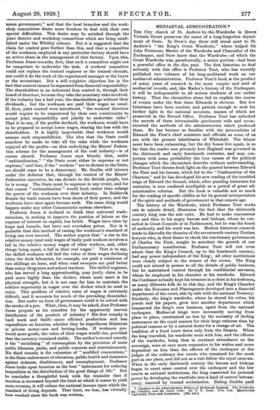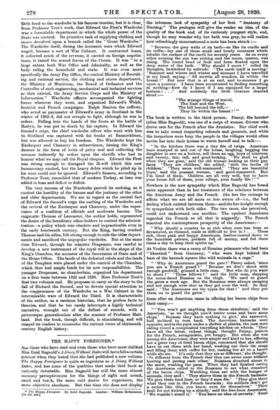MEDIAEVAL ADMINISTRATION.• THE City church of St. Andrew-by-the-Wardrobe in Queen
Victoria Street preserves the name of a long-forgotten depart. ment of State. In Stow's day there still stood next to St. Andrew's " the King's Great Wardrobe," where lodged Sir John Forteacue, Master of the Wardrobe and Chancellor of the Exchequer, and Stow knew that the Wardrobe—of which the Great Wardrobe was, paradoxically, a minor portion—had been a powerful office in the dim past. The first historian to deal seriously with this office is Professor Tout, who has recently published two volumes of his long-meditated work on our mediaeval administration. Professor Tout's book is the product of many years of research in the most cryptic and arid of mediaeval records, and, like Madox's history of the Exchequer, it will be indispensable to all serious students of our earlier history. That the chroniclers alone fail to explain the course of events under the first three Edwards is obvious. But few historians have been resolute and patient enough to seek for further light in the national accounts, masses of which are preserved in the Record Office. Professor Tout has unlocked the secrets of these interminable parchment rolls and recon- structed the methods of the administration which produced them. He has become as familiar with the personalities of Edward the First's chief ministers and officials as some of us are with the present inhabitants of Whitehall. The labour must have been exhausting, but the dry bones live again, in so far that the reader sees precisely how England was governed in the thirteenth and early fourteenth centuries, and may con- jecture with some probability the true causes of the political changes which the chroniclers describe without understanding. Professor Tout throws fresh light on the quarrel between Edward the First and his barons, which led to the " Confirmation of the Charters," and he has developed his new reading of the troubled reign of Edward the Second, which, after puzzling historians for centuries, is now rendered intelligible as a period of great ad- ministrative reforms: But the book is valuable not so much for the reading of specific riddles as for its general interpretation of the spirit and methods of government in that remote age.
The history of the Wardrobe, which Professor Tout works out in minute detail, illustrates the fact that the thirteenth century king was the sole ruler. He had to make concessions now and then to his angry barons and bishops, whom he con- sulted in Great Councils or in Parliaments, but he was the fount of authority and his word was law. Modern historical research tends to discredit the theories of the seventeenth century Puritan lawyers who, in their desire to check the reactionary government of Charles the First, sought to antedate the growth of our Parliamentary constitution. Professor Tout will not even admit that the King's Council, up to the fourteenth century, had any power independent of the King ; all other institutions were clearly subject to the wearer of the crown. The King could not attend in person to all the details of public business, but he maintained control through his confidential servants, whom he employed in his chamber or his wardrobe. Edward the Confessor actually kept his treasure in a chest in his bedroom, as many illiterate folk do to this day, and the King's Chamber under the Normans and Plantageneta developed into a financial department of the court, side by side with the national Treasury. Similarly, the king's wardrobe, where he stored his robes, his jewels and his papers, grew into another department which transacted the king's own business, apart from the national exchequer. Mediaeval kings were incessantly moving from place to place, constrained no less by the necessity of finding sustenance on the royal manors for their large retinues than by political reasons or by a natural desire for a change of air. The tradition of a fixed court dates only from the Stuarts. When the king travelled, his wardrobe went with him, and the officers of the wardrobe, being thus in constant attendance on the sovereign, were at once more responsive to his wishes and more dependent on him than the officers of the exchequer or the judges of the ordinary law courts who remained for the most part in one place, and did not as a rule follow the royal caravan. When in the early thirteenth century the barons and bishops began to exert some control over the exchequer and the law courts as national institutions, the king reasserted his personal power by developing the wardrobe into a kind of central bureau- cracy, manned by trusted ecclesiastics. Bishop Stubbs paid
• Chapters in the Administrative History of Mediaeval England. The Wardrobe. the Chamber. and the Small Seals. By T. F. Tout. Two yob. Idattekesteli University Press and Longman. [36s. net.l little heed to the wardrobe in his famous treatise, but it is clear, from Professor Tout's work, that Edward the First's Wardrobe was a formidable department in which the whole power of the State was centred. Its primitive task of supplying clothing and stores devolved upon a branch called the " Great Wardrobe." The Wardrobe itself, during the incessant wars which Edward waged, became a sort of War Cabinet. It contracted loans, it collected much of the revenue, it carried on foreign negotia- tions, it raised the armed forces of the Crown. It was " to a large extent both. War Office and Admiralty, as well as the body ruling the household and state. It was even more specifically the Army Pay Office, the central Ministry of Recruit- ing and national service, the clothing and stores department, the Ministry of Munitions, the Board of Ordnance and the Controller of such engineering, mechanical and technical services as then existed, the Army Service Corps and the Ministry of Information." Wardrobe officers accompanied the fighting forces wherever they went, and organized Edward's Welsh, Scottish and French campaigns. Ralph Manton the cofferer, who acted as paymaster of Edward's army in Scotland in the winter of 1302-3, did not scruple to fight, although he was in orders. Falling into the hands of the Scots at the battle of Roslyn, he was put to death by his captors. In Edward the Second's reign, the chief wardrobe officer who went with him to Scotland was captured with his books at Bannockburn, but was allowed to buy his freedom. The Wardrobe kept the Exchequer and Chancery in subservience, issuing the King's decrees in the form of writs of privy seal and collecting, the revenue indirectly by orders upon the sheriffs who had to honour what we may call the Royal cheques. Edward the First was strong enough to disregard the ill-will which this new bureaucracy excited, but the heavy debts which he piled up in his wars could not be ignored. Edward's finance, according to Professor Tout, resembled that of modern Turkey, as loan was added to loan and deficit to deficit.
The very success of the Wardrobe, proved its undoing, as it excited the hostility of the barons and the jealousy of the other and older departments. We are to regard as the central fact of Edward the Second's reign the curbing of the Wardrobe and the revival of the Exchequer and Chancery, under the super- vision of a coalition of officials and moderate barons. The enigmatic Thomas of Lancaster, the author holds, represented the desire of the hereditary office-holders to control the adminis- tration—a policy which was obsolete and impracticable even in the early fourteenth century. But the King, having crushed Thomas and his allies, felt strong enough to rule the older depart- ments and sacrificed the unpopular wardrobe. But at the same time Edward, through his minister Despenser, was careful to develop a new instrument of the royal will in the shape of the King's Chamber, the ancestor of the Secretaries of State and of the Home Office. The lands of the. efeated rebels and the lands of the Templars were placed under the control of the Chamber, which thus had ample funds for its new responsibilities. The younger Despenser, as ehamberlain, organized his department on a firm basis between 1322 and 1326. Here Professor Tout's first two volumes end. He.proposes to carry on the story to the fall of Richard the Second, and to devote special attention to the reappearance of the Wardrobe as a War Cabinet in the interminable- wars of Edward the Third. It is characteristic of the author, as a cautious historian, that he prefers facts to theories, and that he too rarely interrupts a highly technical narrative, wrought out of the dullest of records, with a picturesque generalization after the manner of Professor Mait- land. But the book, though difficult, is stimulating,, and will compel its readers to reconsider the current views of thirteenth. century English history.



































 Previous page
Previous page